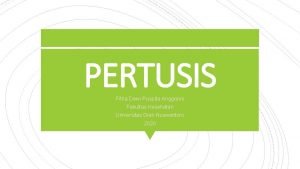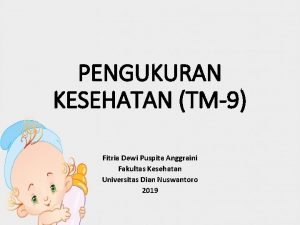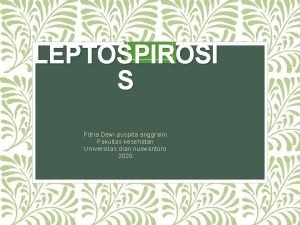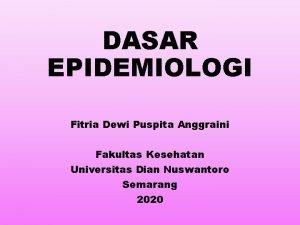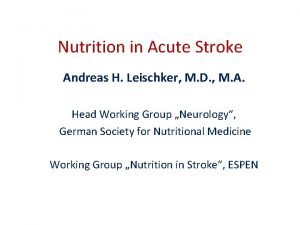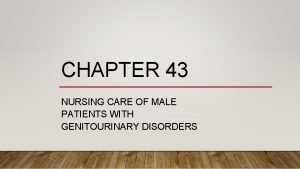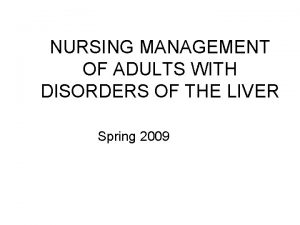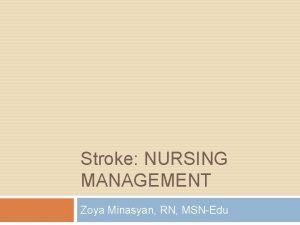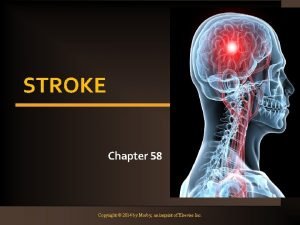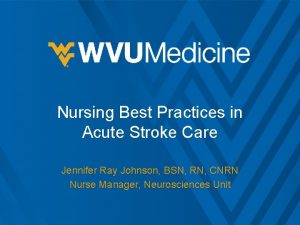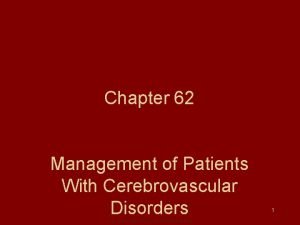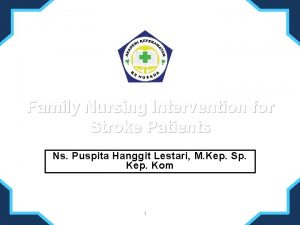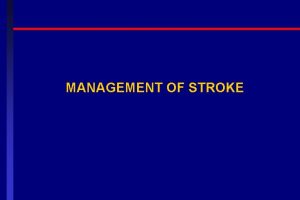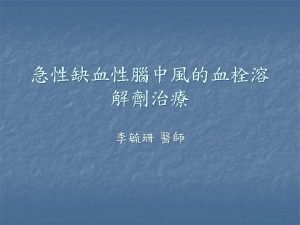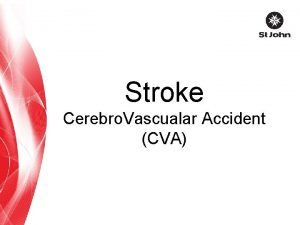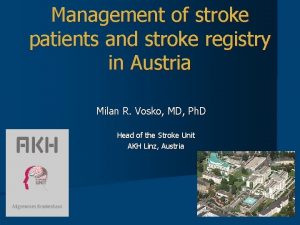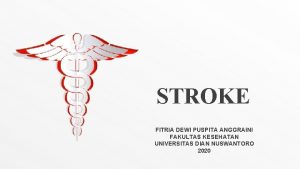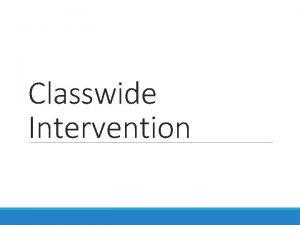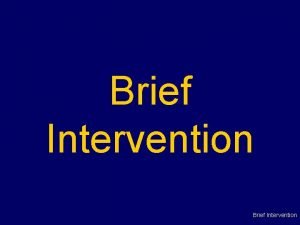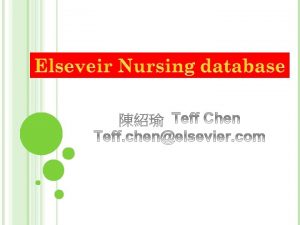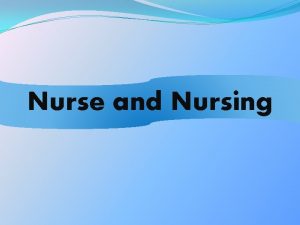Family Nursing Intervention for Stroke Patients Ns Puspita

















- Slides: 17

Family Nursing Intervention for Stroke Patients Ns. Puspita Hanggit Lestari, M. Kep. Sp. Kep. Kom 1

Stroke In Indonesia • • The prevalence of stroke in Indonesia increased from 8. 3 per mile (2007) to 12. 1 per mile (2013) DKI Jakarta is a city with the third highest prevalence of stroke that is 9. 7 per mile (Riskesdas, 2013) Sulut 10, 8 ‰ Babel 9, 7‰ DKI 9, 7‰ Yogya 10, 3%, www. akperhusada. ac. id

Prevalence of Indonesian Stroke Survivor www. akperhusada. ac. id

Impact of Stroke Emotional and Behavioral Conditions Physical Effects Caregiver burden Financial effect www. akperhusada. ac. id

Emotional and Behavioral Conditions Depression Anxiety Memory Loss Pseudobulbar Affect (PBA) (crying or laughing at unexpected, sometimes inappropriate times) Dementia www. akperhusada. ac. id

Physical Effects • Fatigue • Dysphagia (swallowing problems) • Shoulder Pain (on the affected/recovering side of the body} • Central Pain Syndrome (unexplainable pain, temperature sensitivity, sensitivity to light and touch) • Vision Problems • Balance Issues • Claw Toe and Hammertoe • Foot Drop • Seizures • Spasticity (tightening of the muscles in the affected limb) www. akperhusada. ac. id

Left Brain Effects Injury on the left side of the brain may cause: • Paralysis on the right side of the body • Aphasia is language impairment that inhibits your ability to use or comprehend words • Apraxia of speech (verbal apraxia) is difficulty initiating and executing voluntary movement patterns necessary to produce speech when there is no paralysis or weakness of speech muscles • Slow, cautious behaviors www. akperhusada. ac. id Right Brain Effects Damage on the right side may cause: § Paralysis on the left side of the body § Left-side neglect § Quick, impulsive behavioral style

Homonymous Hemianopsia (Food on left side is not seen) Spatial and perceptual deficits in stroke. Perception of a patient with homonymous hemi anopsia Shows that food on the left side is not seen and thus is ignored. www. akperhusada. ac. id

Brain Stem Effects • When stroke occurs in the brain stem, depending on the severity of the injury, it can affect both sides of the body and may leave someone in a “locked-in” state. When a locked in state occurs, the patient is generally unable to speak or achieve any movement below the neck. • Additionally, brain stem stroke may cause ataxia, which is the body’s inability to coordinate how muscles move together. Ataxia may affect the movement of arms, legs and chest muscles and may be associated with tremors. www. akperhusada. ac. id

The Role of Families in Post-Stroke Patient Care Post-stroke patients need further rehabilitation to be able in carrying out daily activities and control the risk factors to prevent another stroke Family social support is needed for the post stroke patients to adapt to changes or disabilities post stroke Family support can help stroke recovery and understanding psychosocial improvements for stroke patients www. akperhusada. ac. id

Stroke Caregiver Burden Several studies conducted on families with elderly post-stroke have shown that families feel the burden of caring for moderate to severe levels (Da costa et al. , 2015; Roopchand & Creary, 2015; Mc. Cullagh, Brigstocke, Donaldson & Karla, 2005). The burden of caring for the elderly can trigger acts of violence and neglect in the elderly (Maryam et al. , 2013). High care burden has a significant relationship with reduced quality of life of stroke patients (Isaac, Stewart & Krishnamoorthy, 2011) www. akperhusada. ac. id

Nursing Diagnosis NANDA 2018 -2020 • Impaired Physical Mobility • Impaired Verbal Communication • Disturbed Sensory Perception • Ineffective Coping • Self-care deficit • Risk for impaired swallowing • Activity intolerance • Risk for unilateral neglect • Deficient knowledge www. akperhusada. ac. id § Disabled family coping § Ineffective family health management § Caregiver role strain § Ineffective health maintenance § Risk-prone health behaviour § Dysfunctional family procces § And another nursing diagnosis

Nursing Intervention (Day, et al (2018) • (1) consider the prior knowledge of family caregivers; • (2) observe how they develop care according to their socio-cultural environment, experiences and financial resources; • (3) encourage family caregivers to think reflectively about how care is being developed; • (4) prepare the care intervention with the family caregiver using previous experiences along with the new information offered and • (5) respect the knowledge of the family caregiver when performing the care. www. akperhusada. ac. id

www. akperhusada. ac. id

Rehabilitation for Stroke Patient • Rehabilitation nursing • Physical therapy • Occupational therapy • Speech, language, and/or hearing therapy • Recreational therapy • Nutritional care • Rehabilitation counseling • Social work • Psychiatric or psychological treatment • Chaplaincy • Patient/family education • Support groups • Vocational evaluation • Driver’s training • Programs to improve physical and emotional stamina to return to work www. akperhusada. ac. id

Nursing home care educational intervention • The family caregivers face difficulties related to the instrumental, emotional and financial support and also the lack of knowledge and skills to perform the activities of care • (1) guide the family caregiver to assist the stroke survivors in daily living at home and for the use of health services; • (2) teach family caregivers about oral or nasoenteric feeding, personal hygiene, bathing, diaper changing, dressing and undressing, transfer, positioning, medication care, handling of devices, such as vesicles and ostomies, if necessary; • (3) provide orientation related to the stroke, causes and consequences of the disease, how to prevent a new stroke, what resources the care network offers, and how to access them; • (4) provide emotional support to the family caregiver and the stroke survivors and • (5) provide educational material www. akperhusada. ac. id

Refference : • American Stroke Association. Caregiver Guide to Stroke. • Da Costa, T. F. , De Freitas Macêdo Costa, K. N. , Martins, K. P. , De Melo Fernandes, M. G. , Da Silva Brito, S. (2015). Burden over family caregivers of elderly people with stroke. Esc. Anna Nery vol. 19 no. 2 Rio de Janeiro Apr. /June 2015 diakses dari http: //www. scielo. br/scielo. php? pid=S 141481452015000200350&script=sci_arttext&tlng=en • Kemenkes R. I. (2013). Riset Kesehatan Dasar. Badan Penelitian dan Pengembangan Kesehatan Kementrian Kesehatan RI. • Isaac, Stewart & Krishnamoorthy. (2011). Caregiver Burden and Quality of Life of Older Persons With Stroke. Journal of Applied Gerontology October 2011 vol. 30 no. 5 643 -654. Diakses dari http: //jag. sagepub. com/content/30/5/643. abstrac • Lestari, P. H ( 2016). Correlation Between Family Caregiver Burden and Elderly’s Quality of Life Post-Stroke in Jakarta Selatan. TESIS. Pascasarjana FIKUI www. akperhusada. ac. id
 Nursing interventions for stroke patients
Nursing interventions for stroke patients Teori dan perilaku organisasi anggri puspita sari
Teori dan perilaku organisasi anggri puspita sari Ica puspita dewi anggraini
Ica puspita dewi anggraini Ica puspita dewi anggraini
Ica puspita dewi anggraini Ica puspita dewi anggraini
Ica puspita dewi anggraini Peristiwa bersejarah epidemiologi wabah diare di london
Peristiwa bersejarah epidemiologi wabah diare di london Leischker
Leischker Anterior stroke vs posterior stroke
Anterior stroke vs posterior stroke Nursing bed positions
Nursing bed positions Care plan on cataract
Care plan on cataract Nursing intervention for ocd
Nursing intervention for ocd Nursing care of male patients with genitourinary disorders
Nursing care of male patients with genitourinary disorders Health education on hepatitis ppt
Health education on hepatitis ppt Nursing intervention for aphasia
Nursing intervention for aphasia Nursing management of stroke
Nursing management of stroke Stroke precautions nursing
Stroke precautions nursing Complications of hydrocephalus
Complications of hydrocephalus Hemianopsia nursing interventions
Hemianopsia nursing interventions


